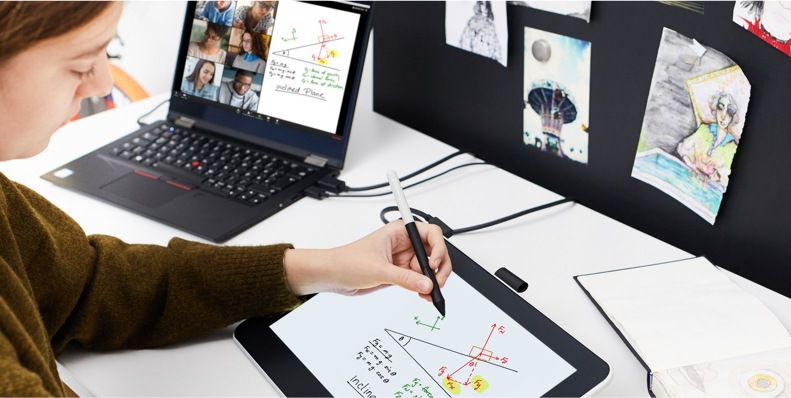



有效協作所帶來的創造可能性是無可限量的。我們的想法在與他人分享或切磋的過程中,會更臻完善。無論是調整策略或開發新專案的初步想法,當我們大家一起這樣做,我們的做法就能更加有創意。
那麼,如果遠距工作和隔離是非自願的時候,創造性協作會變成什麼樣呢?會變得比較沒有效果嗎?倒不盡然。正如這些實用原則與技巧揭示的,視訊通話與虛擬腦力激盪活動對於開發想法與完善專案內容同樣有效。
那麼,如果遠距工作和隔離是非自願的時候,創造性協作會變成什麼樣呢?會變得比較沒有效果嗎?倒不盡然。正如這些實用原則與技巧揭示的,視訊通話與虛擬腦力激盪活動對於開發想法與完善專案內容同樣有效。

舉行大型群組視訊通話可能會讓人覺得很有挑戰性。好消息是,有許多服務都是為了處理多方通話者而設計,也有無數種技術可以確保每個人有投入和參與感。一方面來說,與標準通話不同,進行多方通話時比較不會忍不住同時做好幾件事。畢竟,同事能夠看到彼此伸手拿手機或看向房間另一邊。
每個人都加入通話後,請確保輪流向每個人問好。在事先已透過電子郵件分享議程的同時,鼓勵大家在視訊會議中用聊天工具分享想法及提出問題,不要在別人說話時打斷他們的思路,會是個明智之舉。
這在討論特定問題或事項時也很有用。向視訊通話中的每個人提問,但不要讓他們每個人出聲發言,而是請他們在五分鐘的短暫休息期間,在聊天欄傳送他們的答覆。如此一來,大家的想法經過整理之後,由會議主持人分享,然後在小組中進行討論。
關鍵是要讓視訊通話裡的每個人有參與感,讓他們覺得自己有所貢獻。在這裡,肢體語言對於提升士氣來說至關重要。點頭或豎起大拇指就能給人力量。這讓視訊通話與互動變得更透明,也更人性化。
最理想的視訊會議軟體不只能讓你與同事面對面交談,還可以讓你及時分享螢幕並加上註釋。這個功能在進行簡報或處理新專案時特別有用。充分利用 Wacom 最先進的數位板和液晶顯示器,在你正在討論的文件部分畫圈或畫底線。此外,也鼓勵其他人輪流分享自己的螢幕,這樣每個人都可以在討論時看到他們正在談的內容。
這可以讓視訊通話與辦公室會議一樣有成效。通話者能夠即時查看大家正在討論的內容,並且隨著會議推進深入研究文件、簡報或螢幕上的筆記,這代表他們也可以伴隨對話提出各種解決方案和想法。
此外,通話進行時也可以編輯共享文件,讓每個人都能把自己的想法與創意集中在同一個地方。接著在會議結束後,所有人都可以輕鬆存取文件。

辦公室裡的腦力激盪活動經常不如預期,遠距工作環境中也很有可能會這樣。好消息是,透過一些簡單的規則,就能讓這些活動更有成效。首先,一定要使用提供輕鬆視覺協作的特定線上腦力激盪平台。
最重要的是,應該要有一個人擔任主持人,負責主持活動,專心留下會議紀錄以便之後採取行動。活動開始之前,主持人應針對討論主題規定時間限制(最好是一天以上),請參加視訊通話的人提出想法。這些想法不應在視訊通話前與會議群組分享,而是獨自考慮,如此才能確保聽到每個人的看法。
視訊通話期間,為每個人設置時間限制,讓他們討論自己的想法。這些想法可以加到虛擬白板工具中。繪圖板能讓這個過程變得更輕鬆自然。所有的想法都寫到白板上後,再為討論這些想法設置一個時間限制。會議結束後,應使用群組聊天工具共享大家討論出來的行動,讓大家瞭解接下來的步驟,以及需要什麼才能實現這些目標。實際上,結束腦力激盪後能夠離開並獨自在既定任務上工作,反而讓這個方法的效果比在辦公室好,因為在辦公室,其他工作專案可能會分散注意力。
推薦產品

Wacom One 13
以精準的數位筆在高解析度螢幕上進行直覺式繪圖、設計和創作。
透過自然的介面技術讓人與科技緊密相依,是 Wacom 一貫的願景。這項願景讓 Wacom 成長為全球的互動式數位板、手寫液晶顯示器及數位筆的龍頭製造商,更是數位簽章保存與處理解決方案供應商。Wacom 直覺式輸入裝置的先進技術,已在全球各地造就出許多一流數位藝術、電影、特效、時尚及設計鉅作,其領先的介面技術同時為商業和家庭用戶提供表達自我個性的利器。創立於 1983 年的 Wacom 是全球性企業,總部位於日本(東京證券交易所股號:6727),分公司及行銷與銷售代表處遍佈世界各地 150 多個國家。